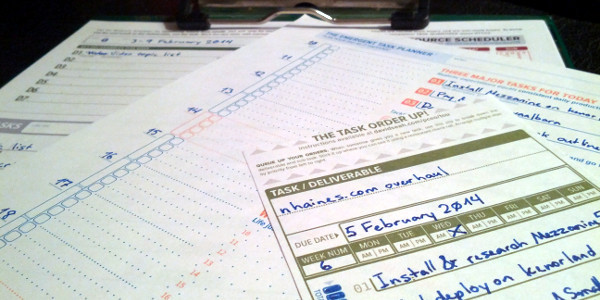

February 14, 2014

Everyone loves making excuses. When a new year rolls around, one day is much like the next. But people actually use a new year as an excuse to take stock, stop making excuses, and resolve to do things differently. For many, 2014 is a new start and I think that another January is as good an excuse as any to make plans.
I spent the last weekend of 2013 doing major cleaning. I straightened up the half of my bedroom that counts as my home office, got my printer set up in its rightful space on top of the end table/bookshelf by my computer desk so I can use the scanner, bought new ink cartridges, moved around inspirational and educational books to the office bookshelf, and mounted my whiteboard again. I also bought a check holder rail to mount under my whiteboard. With a clean desk, easy office supply access, and a big whiteboard with a ton of dry-erase markers, I was ready to plan for the year. One of the big problems with freelancing is time management. There are a lot of things to do, but there are also a lot of pictures of cats to look at on reddit. Between the two, it’s easy for important goals to slip between the cracks. In 2014, I decided to go back to a paper-based time management system that worked so well for my first private IT job years ago. It was invented by David Seah and is called the Printable CEO. This system is a collection of mix and match forms which allow you to track time in a variety of ways. You can use any form on its own or combine them to track various projects. It has its foundation in the Getting Things Done method of time management.
When I first started working in IT after graduating, my boss was quite busy with a lot of things, and asked me to keep track of my time and send him a weekly report of the things I worked on. I had never needed to do this before and was able to find the Printable CEO series through searching for time management forms. The Resource Time Tracker was the perfect tool to track my tasks throughout the week, and I actually used the short weekly form on its own week after week. Not only could I see where my time was going, but after a couple of weeks I could actually use it to plan out new projects. When I started writing business reports in Python, it was very useful to know how much actual work I needed to do and how much time I could spend automating. I’ve started a long-term project with a friend that seems just right for these forms and I’ve put it into practice for the first time this month.
For my own day-to-day planning, what I really need is accountability. Every working day since the last week of December, I’ve used the Emergent Task Planner. It’s a single-page sheet that has three work periods (separated with one-hour breaks) where you can list three (or more) major tasks for the day, estimate the time they will take, and then plan when you’ll work on them. There’s another large section for notes and other things. The nice thing about this form is that it was meant to work with the Pomodoro technique, where you work in set intervals. These forms use a 15-minute interval. This means that for every 15 minutes you work on a task, you get to fill in a bubble marking your time spent. This is a silly but addictive reward for getting things done and I’ve found that it works really well for me. I use this for single-day tasks that I know I can finish as well as planning to work on multi-day tasks.
For tasks that need to be tracked over multiple days, I use a form called the Task Order Up. This is like an order check used in restaurants around the world. I write down a task and break it into discrete steps. Then I work on each step and fill in a bubble every 15 minutes. I printed a page of each available color and keep green for direct freelance work, orange for Ubuntu work, and black for anything else. I actually ordered a check rail holder just for these slips. Having them in front of me beside my monitor is a great reminder of my progress.
For its own part, Ubuntu has been a big help in keeping me productive. I’m a big fan of Unity, and with the Launcher hidden, Unity really makes it easy to focus on my work at all times. When I need quick information, the Dash search in Ubuntu 13.10 lets me quickly find not just applications, but also the files and folders I’ve recently worked on for each application. I can do a search and find the folders and files I’ve been working on and open them quickly. Occasionally I’ll put on background music, and the Dash is up to snuff with music searches as well. Meanwhile the messaging indicator keeps me aware of incoming emails without diverting my attention. And the date indicator keeps track of any appointments I enter into my Google account via my phone. There are a few Pomodoro apps for Ubuntu, but I don’t use them personally. I prefer to keep track of start and stop times myself. Still, Ubuntu is one of the major reasons I’ve been productive this year! Well, if you don’t count the time I’ve spent playing Kerbal Space Program via Steam, anyway.
This year I set out to renovate the way I do business, and I found some wonderful, clean time management forms I can use on paper. Ubuntu continues to be the perfect fit for my desktop and laptop computers. Thanks to this combination of organization and accountability, I’ve been able to really get work done and adjust my schedule for my strengths and weaknesses. A month and a half into 2014, the year’s looking bright. I’m grateful to combine the best of legacy time organization and the best software in computing to create a powerful foundation to build on.